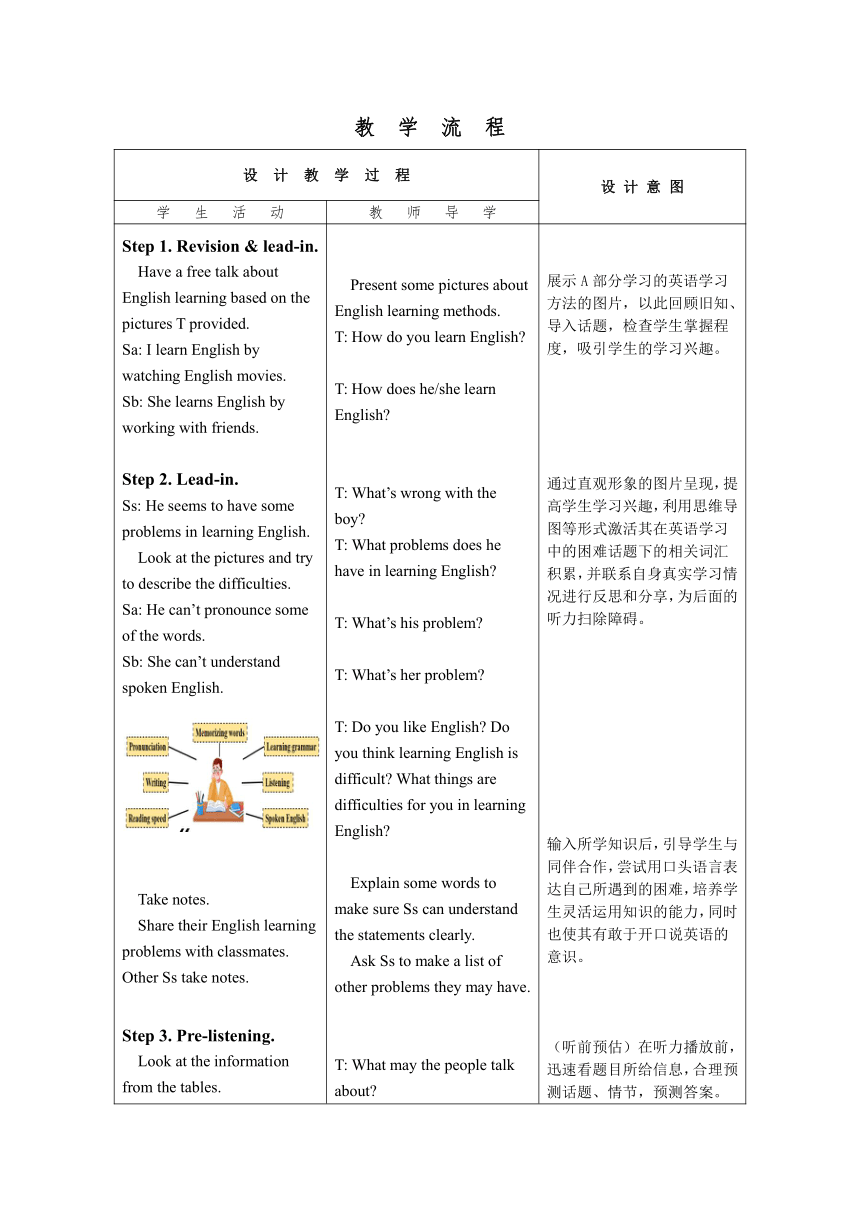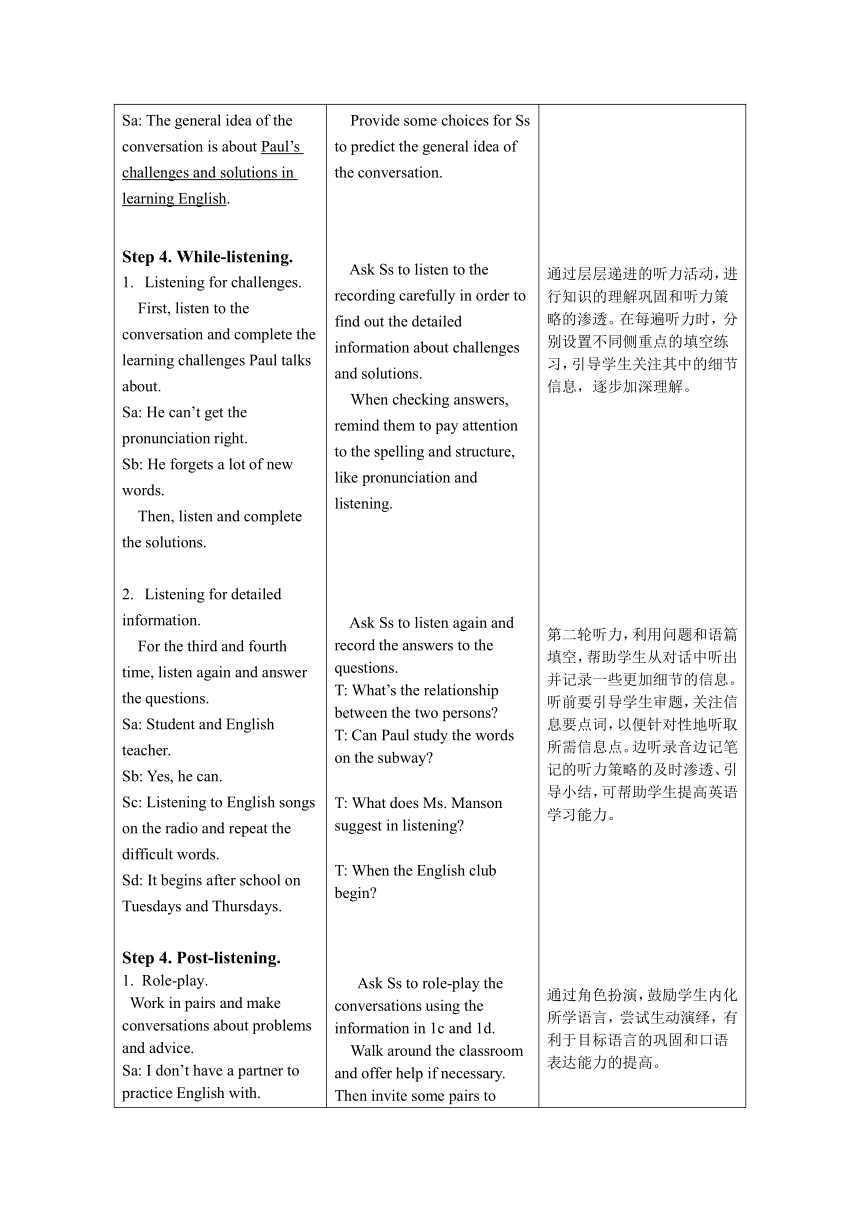人教版九年级全册Unit 1 How can we become good learnersSection B 1a-1d教学设计(表格式,含核心素养目标)
文档属性
| 名称 | 人教版九年级全册Unit 1 How can we become good learnersSection B 1a-1d教学设计(表格式,含核心素养目标) |  | |
| 格式 | docx | ||
| 文件大小 | 480.4KB | ||
| 资源类型 | 教案 | ||
| 版本资源 | 人教新目标(Go for it)版 | ||
| 科目 | 英语 | ||
| 更新时间 | 2024-09-23 19:06:50 | ||
图片预览



文档简介
课 时 教 学 设 计 首 页
授课时间:2022年 月 日
课题 Unit 1 How can we become good learners Section B (1a-1d) 班级 备课教师
课型 听说课 课时 4
核心素养与思政渗透 本课时的话题围绕英语的学习困难(challenges)和解决方案(solutions)展开,在此语境下引导学生巩固了A部分所学语言结构,丰富与英语学习相关的话题词汇;在语言技能上,将听、说能力综合;在学习能力和策略上,引导学生关注优秀学生的学习方式,借鉴并用于自身;在情感上,鼓励学生直面学习困难,积极探索解决方案,不断改进自己的学习方法、提高学习效率。
课标分析 新课标要求九年级学生能听懂发音清晰、语速较慢的简短口头表达,获取关键信息;在听、读、看的过程中,围绕语篇内容记录重点信息,整体理解和简要概括主要内容;能围绕相关主题,运用所学语言,与他人进行日常交流,语音、语调、用词基本正确,表达比较连贯;对英语学习有持续的兴趣和较为明确的学习需求与目标;能主动参与课内外各种英语实践活动,注意倾听,积极使用英语进行交流,遇到问题主动请教,勇于克服困难;能找到适合自己的英语学习方法。
教学目标 语言能力 能够在“英语学习经验”分享会的情境中正确使用更加丰富的词汇表达和多种提建议句型,以听、说等方式理解和谈论有关英语的学习困难(challenges)和解决方案(solutions);能够提升听说技能,如听前预测、听中笔记等;
文化品格 能够学会自我反思,找出自己英语学习中遇到的困难,主动调整自己的英语学习方式,根据自己的学习特点选择相应的学习策略和方案;
思维品质 能够在听说活动中准确获取并清晰表达有关英语的学习困难和解决方案方面的信息,提高思维的逻辑性、深刻性和批判性;
学习能力 能够通过谈论如何学习英语的话题,保持对英语学习的兴趣,明确自己的学习需求和目标;通过听力及口语策略的感悟、体验和学习,形成良好的学习习惯,提高学习效率;能与人积极交流并主动反思自己英语学习中的进步与不足,努力查找原因并加以解决。
教材内容分析 本课是一节听说课,在A部分谈论英语学习的基础上,进一步谈论英语的学习困难(challenges)和解决方案(solutions)。1a-1e是围绕英语学习的任务链活动。1a-1b让学生思考自己英语学习有哪些困难,并写出来。1a列举的学习困难也为后面1c-1d的听力谈论的相关话题进行了预热。1e需要学生结合所听内容,用对话形式复现听力信息。
重点 与英语学习的困难和解决方案相关的词汇;提建议句型的巩固和运用;
难点 有效掌握丰富的有关英语学习的短语和搭配;反思自我出现的困难并合理提出有效解决方案。
学情分析 经过多年的英语学习,刚入九年级的学生已掌握了一定量的英语语言知识并知晓部分英语学习策略。通过七、八年级的学习,也掌握了一系列陈述问题和提出建议的句式结构,这将有助于本节课对英语学习中出现的困难和解决方案的深入学习和思考。同时,要借机引导学生多反思自己的优秀经验和学习策略上的不足和缺失,不断改进自己的学习方法、提高学习效率。
第 页
教 学 流 程
设 计 教 学 过 程 设 计 意 图
学 生 活 动 教 师 导 学
Step 1. Revision & lead-in. Have a free talk about English learning based on the pictures T provided. Sa: I learn English by watching English movies. Sb: She learns English by working with friends. Step 2. Lead-in. Ss: He seems to have some problems in learning English. Look at the pictures and try to describe the difficulties. Sa: He can’t pronounce some of the words. Sb: She can’t understand spoken English. Take notes. Share their English learning problems with classmates. Other Ss take notes. Step 3. Pre-listening. Look at the information from the tables. Sa: The general idea of the conversation is about Paul’s challenges and solutions in learning English. Step 4. While-listening. Listening for challenges. First, listen to the conversation and complete the learning challenges Paul talks about. Sa: He can’t get the pronunciation right. Sb: He forgets a lot of new words. Then, listen and complete the solutions. Listening for detailed information. For the third and fourth time, listen again and answer the questions. Sa: Student and English teacher. Sb: Yes, he can. Sc: Listening to English songs on the radio and repeat the difficult words. Sd: It begins after school on Tuesdays and Thursdays. Step 4. Post-listening. Role-play. Work in pairs and make conversations about problems and advice. Sa: I don’t have a partner to practice English with. Sb: Maybe you should join an English club. 2.Discussion. Work in groups and have a discussion about their advice and solutions. Three minutes later, some Ss report their results in class. Sa: We think ... In my group, Alice has problems in reading. We advise her to ... Step 5. Conclusion. Have a summary of what we have learned with the help of T. Do some exercises. Present some pictures about English learning methods. T: How do you learn English T: How does he/she learn English T: What’s wrong with the boy T: What problems does he have in learning English T: What’s his problem T: What’s her problem T: Do you like English Do you think learning English is difficult What things are difficulties for you in learning English Explain some words to make sure Ss can understand the statements clearly. Ask Ss to make a list of other problems they may have. T: What may the people talk about Provide some choices for Ss to predict the general idea of the conversation. Ask Ss to listen to the recording carefully in order to find out the detailed information about challenges and solutions. When checking answers, remind them to pay attention to the spelling and structure, like pronunciation and listening. Ask Ss to listen again and record the answers to the questions. T: What’s the relationship between the two persons T: Can Paul study the words on the subway T: What does Ms. Manson suggest in listening T: When the English club begin Ask Ss to role-play the conversations using the information in 1c and 1d. Walk around the classroom and offer help if necessary. Then invite some pairs to show in class. T: What’s your advice to Paul T: Think about your problems in English learning and try to find the solutions. 展示A部分学习的英语学习方法的图片,以此回顾旧知、导入话题,检查学生掌握程度,吸引学生的学习兴趣。 通过直观形象的图片呈现,提高学生学习兴趣,利用思维导图等形式激活其在英语学习中的困难话题下的相关词汇积累,并联系自身真实学习情况进行反思和分享,为后面的听力扫除障碍。 输入所学知识后,引导学生与同伴合作,尝试用口头语言表达自己所遇到的困难,培养学生灵活运用知识的能力,同时也使其有敢于开口说英语的意识。 (听前预估)在听力播放前,迅速看题目所给信息,合理预测话题、情节,预测答案。 通过层层递进的听力活动,进行知识的理解巩固和听力策略的渗透。在每遍听力时,分别设置不同侧重点的填空练习,引导学生关注其中的细节信息,逐步加深理解。 第二轮听力,利用问题和语篇填空,帮助学生从对话中听出并记录一些更加细节的信息。 听前要引导学生审题,关注信息要点词,以便针对性地听取所需信息点。边听录音边记笔记的听力策略的及时渗透、引导小结,可帮助学生提高英语学习能力。 通过角色扮演,鼓励学生内化所学语言,尝试生动演绎,有利于目标语言的巩固和口语表达能力的提高。 情景创设下的小组活动,是对语言的综合运用输出,能锻炼学生的语言掌握和运用能力、团队协作能力等。适当的语言支撑的提供是不可缺少的。 总结提炼,帮助学生归纳本课所学重点内容,并使他们意识到当别人困难时要伸出援助之手。
第 页
课 时 达 标 检 测
Ⅰ.选词并用其恰当形式填空。 1.The car is running at a of 110 kilometers an hour. 2.I'm so lucky to have Annie as my when I practice my English. 3.I don't know how my income(收入). 4.I can't some of the words well , so I should ask the teacher for help. 5.Be more careful, or you will make . . Ⅱ. 按中文提示完成句子。 6. 我们通过大声朗读学习英语。 We learn English ___ ______ _____. 7. Pierre 经常在语法方面犯错。 Pierre often ______ ________ ___ grammar. 8. 这个问题有许多解决方法。 There are many __________ ___ ___ _________. 9. 我没有一个可以和我练习英语的搭档。 I don’t have a partner ___ ________ ________ _____. 10. 你为什么不向他求助呢? _____ _____ _____ ask him for help
第 页
课 时 教 学 设 计 尾 页
板 书 设 计
Unit 1 How can we become good learners (Section B 1a-1d)
作 业 设 计
Level A After class, do a survey among ten of your friends or classmates about the challenges they met in English learning. Draw a chart about your survey results and write an article about the results and your advice and opinions.
Level B List 7 challenges and solutions about English learning, including the ones in textbooks.
教 学 反 思
第 页
授课时间:2022年 月 日
课题 Unit 1 How can we become good learners Section B (1a-1d) 班级 备课教师
课型 听说课 课时 4
核心素养与思政渗透 本课时的话题围绕英语的学习困难(challenges)和解决方案(solutions)展开,在此语境下引导学生巩固了A部分所学语言结构,丰富与英语学习相关的话题词汇;在语言技能上,将听、说能力综合;在学习能力和策略上,引导学生关注优秀学生的学习方式,借鉴并用于自身;在情感上,鼓励学生直面学习困难,积极探索解决方案,不断改进自己的学习方法、提高学习效率。
课标分析 新课标要求九年级学生能听懂发音清晰、语速较慢的简短口头表达,获取关键信息;在听、读、看的过程中,围绕语篇内容记录重点信息,整体理解和简要概括主要内容;能围绕相关主题,运用所学语言,与他人进行日常交流,语音、语调、用词基本正确,表达比较连贯;对英语学习有持续的兴趣和较为明确的学习需求与目标;能主动参与课内外各种英语实践活动,注意倾听,积极使用英语进行交流,遇到问题主动请教,勇于克服困难;能找到适合自己的英语学习方法。
教学目标 语言能力 能够在“英语学习经验”分享会的情境中正确使用更加丰富的词汇表达和多种提建议句型,以听、说等方式理解和谈论有关英语的学习困难(challenges)和解决方案(solutions);能够提升听说技能,如听前预测、听中笔记等;
文化品格 能够学会自我反思,找出自己英语学习中遇到的困难,主动调整自己的英语学习方式,根据自己的学习特点选择相应的学习策略和方案;
思维品质 能够在听说活动中准确获取并清晰表达有关英语的学习困难和解决方案方面的信息,提高思维的逻辑性、深刻性和批判性;
学习能力 能够通过谈论如何学习英语的话题,保持对英语学习的兴趣,明确自己的学习需求和目标;通过听力及口语策略的感悟、体验和学习,形成良好的学习习惯,提高学习效率;能与人积极交流并主动反思自己英语学习中的进步与不足,努力查找原因并加以解决。
教材内容分析 本课是一节听说课,在A部分谈论英语学习的基础上,进一步谈论英语的学习困难(challenges)和解决方案(solutions)。1a-1e是围绕英语学习的任务链活动。1a-1b让学生思考自己英语学习有哪些困难,并写出来。1a列举的学习困难也为后面1c-1d的听力谈论的相关话题进行了预热。1e需要学生结合所听内容,用对话形式复现听力信息。
重点 与英语学习的困难和解决方案相关的词汇;提建议句型的巩固和运用;
难点 有效掌握丰富的有关英语学习的短语和搭配;反思自我出现的困难并合理提出有效解决方案。
学情分析 经过多年的英语学习,刚入九年级的学生已掌握了一定量的英语语言知识并知晓部分英语学习策略。通过七、八年级的学习,也掌握了一系列陈述问题和提出建议的句式结构,这将有助于本节课对英语学习中出现的困难和解决方案的深入学习和思考。同时,要借机引导学生多反思自己的优秀经验和学习策略上的不足和缺失,不断改进自己的学习方法、提高学习效率。
第 页
教 学 流 程
设 计 教 学 过 程 设 计 意 图
学 生 活 动 教 师 导 学
Step 1. Revision & lead-in. Have a free talk about English learning based on the pictures T provided. Sa: I learn English by watching English movies. Sb: She learns English by working with friends. Step 2. Lead-in. Ss: He seems to have some problems in learning English. Look at the pictures and try to describe the difficulties. Sa: He can’t pronounce some of the words. Sb: She can’t understand spoken English. Take notes. Share their English learning problems with classmates. Other Ss take notes. Step 3. Pre-listening. Look at the information from the tables. Sa: The general idea of the conversation is about Paul’s challenges and solutions in learning English. Step 4. While-listening. Listening for challenges. First, listen to the conversation and complete the learning challenges Paul talks about. Sa: He can’t get the pronunciation right. Sb: He forgets a lot of new words. Then, listen and complete the solutions. Listening for detailed information. For the third and fourth time, listen again and answer the questions. Sa: Student and English teacher. Sb: Yes, he can. Sc: Listening to English songs on the radio and repeat the difficult words. Sd: It begins after school on Tuesdays and Thursdays. Step 4. Post-listening. Role-play. Work in pairs and make conversations about problems and advice. Sa: I don’t have a partner to practice English with. Sb: Maybe you should join an English club. 2.Discussion. Work in groups and have a discussion about their advice and solutions. Three minutes later, some Ss report their results in class. Sa: We think ... In my group, Alice has problems in reading. We advise her to ... Step 5. Conclusion. Have a summary of what we have learned with the help of T. Do some exercises. Present some pictures about English learning methods. T: How do you learn English T: How does he/she learn English T: What’s wrong with the boy T: What problems does he have in learning English T: What’s his problem T: What’s her problem T: Do you like English Do you think learning English is difficult What things are difficulties for you in learning English Explain some words to make sure Ss can understand the statements clearly. Ask Ss to make a list of other problems they may have. T: What may the people talk about Provide some choices for Ss to predict the general idea of the conversation. Ask Ss to listen to the recording carefully in order to find out the detailed information about challenges and solutions. When checking answers, remind them to pay attention to the spelling and structure, like pronunciation and listening. Ask Ss to listen again and record the answers to the questions. T: What’s the relationship between the two persons T: Can Paul study the words on the subway T: What does Ms. Manson suggest in listening T: When the English club begin Ask Ss to role-play the conversations using the information in 1c and 1d. Walk around the classroom and offer help if necessary. Then invite some pairs to show in class. T: What’s your advice to Paul T: Think about your problems in English learning and try to find the solutions. 展示A部分学习的英语学习方法的图片,以此回顾旧知、导入话题,检查学生掌握程度,吸引学生的学习兴趣。 通过直观形象的图片呈现,提高学生学习兴趣,利用思维导图等形式激活其在英语学习中的困难话题下的相关词汇积累,并联系自身真实学习情况进行反思和分享,为后面的听力扫除障碍。 输入所学知识后,引导学生与同伴合作,尝试用口头语言表达自己所遇到的困难,培养学生灵活运用知识的能力,同时也使其有敢于开口说英语的意识。 (听前预估)在听力播放前,迅速看题目所给信息,合理预测话题、情节,预测答案。 通过层层递进的听力活动,进行知识的理解巩固和听力策略的渗透。在每遍听力时,分别设置不同侧重点的填空练习,引导学生关注其中的细节信息,逐步加深理解。 第二轮听力,利用问题和语篇填空,帮助学生从对话中听出并记录一些更加细节的信息。 听前要引导学生审题,关注信息要点词,以便针对性地听取所需信息点。边听录音边记笔记的听力策略的及时渗透、引导小结,可帮助学生提高英语学习能力。 通过角色扮演,鼓励学生内化所学语言,尝试生动演绎,有利于目标语言的巩固和口语表达能力的提高。 情景创设下的小组活动,是对语言的综合运用输出,能锻炼学生的语言掌握和运用能力、团队协作能力等。适当的语言支撑的提供是不可缺少的。 总结提炼,帮助学生归纳本课所学重点内容,并使他们意识到当别人困难时要伸出援助之手。
第 页
课 时 达 标 检 测
Ⅰ.选词并用其恰当形式填空。 1.The car is running at a of 110 kilometers an hour. 2.I'm so lucky to have Annie as my when I practice my English. 3.I don't know how my income(收入). 4.I can't some of the words well , so I should ask the teacher for help. 5.Be more careful, or you will make . . Ⅱ. 按中文提示完成句子。 6. 我们通过大声朗读学习英语。 We learn English ___ ______ _____. 7. Pierre 经常在语法方面犯错。 Pierre often ______ ________ ___ grammar. 8. 这个问题有许多解决方法。 There are many __________ ___ ___ _________. 9. 我没有一个可以和我练习英语的搭档。 I don’t have a partner ___ ________ ________ _____. 10. 你为什么不向他求助呢? _____ _____ _____ ask him for help
第 页
课 时 教 学 设 计 尾 页
板 书 设 计
Unit 1 How can we become good learners (Section B 1a-1d)
作 业 设 计
Level A After class, do a survey among ten of your friends or classmates about the challenges they met in English learning. Draw a chart about your survey results and write an article about the results and your advice and opinions.
Level B List 7 challenges and solutions about English learning, including the ones in textbooks.
教 学 反 思
第 页
同课章节目录
- Unit 1 How can we become good learners.
- Section A
- Section B
- Unit 2 I think that mooncakes are delicious!
- Section A
- Section B
- Unit 3 Could you please tell me where the restroom
- Section A
- Section B
- Unit 4 I used to be afraid of the dark.
- Section A
- Section B
- Unit 5 What are the shirts made of?
- Section A
- Section B
- Review of Units 1-5
- Unit 6 When was it invented?
- Section A
- Section B
- Unit 7 Teenagers should be allowed to choose their
- Section A
- Section B
- Unit 8 It must belong to Carla.
- Section A
- Section B
- Unit 9 I like music that I can dance to.
- Section A
- Section B
- Unit 10 You're supposed to shake hands.
- Section A
- Section B
- Review of Units 6-10
- Unit 11 Sad movies make me cry.
- Section A
- Section B
- Unit 12 Life is full of the unexpected
- Section A
- Section B
- Unit 13 We're trying to save the earth!
- Section A
- Section B
- Unit 14 I remember meeting all of you in Grade 7.
- Section A
- Section B
- Review of Units 11-14
